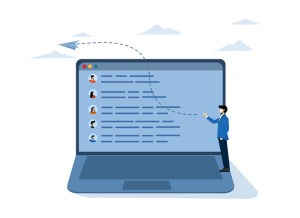Personalized Interactions Takes A Commitment To Detail



For all the hard work and occasional challenges, there are many aspects of working in sales that can be a lot of fun. Travelling to thought-provoking industry events! Getting to know smart and creative customers! All kinds of data entry! Okay, so the data entry part usually isn’t considered all

Salesforce Canada
For all the hard work and occasional challenges, there are many aspects of working in sales that can be a lot of fun.
Travelling to thought-provoking industry events! Getting to know smart and creative customers! All kinds of data entry!
Okay, so the data entry part usually isn’t considered all that much fun.
When you recognize all the ends to which data is a means, however, you realize how closely it is linked to the most fulfilling aspects of working as a sales rep:
- Data helps identify the customers who will most want to hear from you.
- Data will allow you to approach them in a way that makes them feel recognized, distinctive and important.
- Data lets you scale the volume of customers you win, and personalizes the relationship with each of them, keeping everyone happy.
Personalization is even more important in an age where so much of our lives involve digital interactions. Sales people connecting with clients primarily by email or phone need to make sure they can replicate the intimacy of shaking a customer’s hand and greeting them by name when they walk in a store.
Details, details, details!
The details you need in order to personalize anything involves consistently collecting and inputting data into your CRM, which can then become a hub for all your company’s sales and business activities.
Of course, this can be a lot easier said than done, given many reps’ busy schedules. Sometimes you’re rushing from one meeting to the next. Sometimes you get interrupted by a personal call or text. Sometimes you’re just tired.
These are all understandable excuses, but they’re still excuses, and they could cost you in the long run. You’re far less likely to meet or exceed your quota when you fail to have the right data on hand when you’re interacting with a customer.
Follow these rules of thumb to make sure your CRM is so up to date that personalized interactions will look almost effortless to your customers — even if they represent a lot of your dedication and commitment to detail behind the scenes:
1. ’Later’ often leads to ‘never’
Selling and multi-tasking often go hand-in-hand. You’re making a pitch while also reading your customer’s face to begin mentally preparing for the questions you might be asked. You’re closing a deal on the phone while trying to finish an email to another prospect who’s just responded to your initial outreach.
Inputting details into the CRM can easily fall through the cracks amid all these disparate activities.
Try this: instead of thinking a call is done when you hang up, or that writing an email is done when you press “send,” treat entering data into the CRM as your final step in as many actions as possible.
CRM=done. It’s a simple algorithm, but it will make you more productive and successful in the long run.
2. Your shorthand will leave you coming up short
Many offices used to employ full-time stenographers who used a set of symbols to represent words or entire phrases in order to easily take dictation from managers.
Even if you didn’t study stenography in school, you might have your own abbreviations, symbols or other “shorthand” that you use to take notes.
The problem with shorthand today is that we have a tendency to make it up as we go along — and depending on the industry in which you work, customers can throw brand names, technology terms or other jargon that can be difficult to jot down accurately by hand.
Remember that anything you’re capturing in shorthand will need to be clearly understood by anyone who sees your notes in CRM later, not just you.
3. Analog does a disservice to digital
Before your company used a CRM, you may have had your own system for keeping track of data that personalized the way you sold to customers.
The most common examples include sticky notes — which sometimes covered the entire perimeter of a monitor — or a paper pad that could be carried conveniently in a pocket.
Even once a CRM has been deployed, there is sometimes a tendency for reps to continue going back and forth between these approaches — jotting information by hand on a sticky note first, for instance, and then coming back afterwards and typing the data into the CRM.
The challenge is making sure you’ll remember which notes relate to a particular account, or that you’ll understand what the note means hours or even days after you first scribbled it on paper.
Better to start with the digital process to get the most of the digital process.
4. Data analysis improves data record keeping
Perhaps the biggest mental hurdle around inputting CRM data is the question, “Do I really need to add all these details?”
The answer is, maybe not. There might be some details that allow greater personalization of the sales experience than others. But you won’t know until you’ve regularly been adding data, and then analyzing the results of using the data.
Step back every once in a while from your day-to-day work and examine your win/loss rate, the speed at which your average deal closes or your volume of repeat purchases. What CRM data helped contribute to those outcomes? Where did the details allow you to offer a personal touch that nurtured the relationship in a positive way?
This might be a fancy way of saying that practice makes perfect. And it does — the better your records, the better your data. The better your data, the more you can sell based on personalization.
Contrary to what you might have heard, the devil is not in the details. The wins are.




















